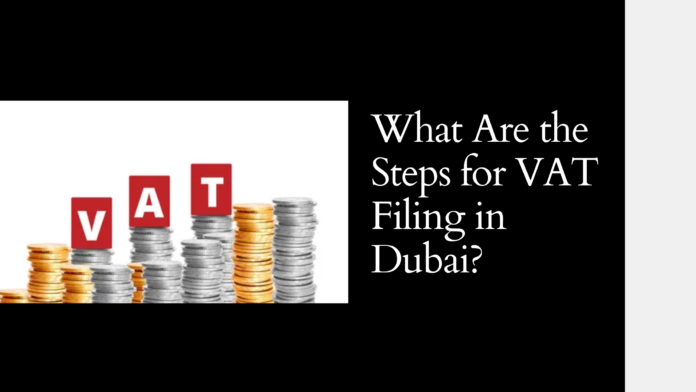Value Added Tax (VAT) is a crucial component of Dubai’s taxation system, introduced in 2018 by the UAE government. VAT filing is a mandatory process for businesses registered under the Federal Tax Authority (FTA). Filing VAT returns correctly and on time ensures compliance, avoids penalties, and maintains smooth business operations. Understanding the process is essential for businesses to manage their tax obligations efficiently. This article outlines the essential steps for VAT filing in Dubai, guiding businesses through the process to ensure seamless compliance.
NOTE :- Timely and accurate VAT filing in Dubai was ensured by M&M Al Menhali Auditing. Businesses remained compliant and avoided penalties. Secure professional VAT filing services today—contact M&M Al Menhali Auditing now!

Understanding VAT Filing in Dubai
VAT is a consumption-based tax applied at a standard rate of 5% on goods and services. Businesses registered for VAT must file periodic returns detailing their taxable sales, purchases, output VAT, and input VAT. The net VAT amount is then either paid to the FTA or reclaimed as a refund if input VAT exceeds output VAT.
Determining VAT Filing Eligibility
Before initiating the VAT filing process, businesses must determine whether they meet the criteria for VAT registration and filing. Companies with an annual taxable turnover exceeding AED 375,000 must register for VAT. Businesses with taxable supplies between AED 187,500 and AED 375,000 have the option to register voluntarily.
Maintaining Accurate Financial Records
Accurate record-keeping is essential for smooth VAT filing. Businesses must maintain comprehensive records of sales, purchases, invoices, and credit notes to calculate the correct VAT amount. The FTA mandates that businesses keep VAT-related records for at least five years.
Accessing the FTA e-Services Portal
VAT returns must be filed through the FTA e-Services portal. Businesses need to log in using their Tax Registration Number (TRN) and access the VAT return form, where they input relevant financial details. The portal provides a structured interface to ensure compliance and accuracy.
Gathering Required Documents
Before filing VAT returns, businesses must collect necessary documents, including sales and purchase invoices, tax invoices, credit and debit notes, and bank statements. These documents support the figures reported in the VAT return and facilitate smooth processing.
Calculating Output VAT and Input VAT
Businesses must calculate their VAT liabilities before filing returns. Output VAT is the tax collected from customers on sales, while input VAT is the tax paid on business-related purchases. The net VAT payable is determined by subtracting input VAT from output VAT. If input VAT exceeds output VAT, the business is eligible for a refund.
Completing the VAT Return Form
The VAT return form on the FTA portal consists of multiple sections where businesses must enter financial data related to taxable supplies, exempt supplies, zero-rated sales, and VAT collected. Each section must be completed accurately to ensure compliance and avoid discrepancies.
Reviewing the VAT Return Before Submission
Before submitting the VAT return, businesses should review all figures to ensure accuracy. Errors in VAT filing can result in penalties or audit scrutiny. It is advisable to cross-check calculations and verify documentation before finalizing the return.
Submitting the VAT Return on Time
VAT returns must be submitted before the deadline to avoid fines. The standard VAT return filing frequency is either monthly or quarterly, depending on the business classification by the FTA. The due date for submission is the 28th of the month following the end of the tax period.
Making the VAT Payment
If a business has a VAT payable amount, payment must be made through one of the FTA’s approved payment channels. Businesses can pay via e-Dirham, bank transfer, or through selected exchange centers. Timely payment ensures compliance and avoids penalties for late submission.
Claiming VAT Refunds
If the input VAT exceeds the output VAT, businesses can apply for a VAT refund. The refund request is processed through the FTA portal, where businesses must submit supporting documentation. Once approved, the refunded amount is credited to the business’s account.
Avoiding Common Mistakes in VAT Filing
Businesses must be aware of common errors in VAT filing, such as incorrect calculations, missing invoices, or misclassification of taxable supplies. Proper record-keeping, periodic reconciliations, and consulting tax professionals can help mitigate these risks.
Utilizing Professional VAT Filing Services
Many businesses seek the assistance of VAT consultants or accounting firms to ensure error-free VAT filing. Professional services help in VAT return preparation, compliance checks, and handling tax audits, reducing the risk of penalties.
Importance of Timely VAT Filing
Timely VAT filing ensures compliance with UAE tax laws and helps businesses maintain good standing with the FTA. Late submissions attract penalties, starting from AED 1,000 for the first offense and increasing for repeated delays.
Conclusion
VAT filing in Dubai is a structured process that requires businesses to maintain accurate records, calculate VAT liabilities correctly, and submit returns on time. By understanding the steps involved and utilizing professional assistance if needed, businesses can ensure compliance and smooth tax operations. Proper VAT management not only helps avoid penalties but also contributes to the financial stability and credibility of the business in the UAE market.
For More Insightful Articles Related To This Topic, Feel Free To Visit: Todaybusinessposts
















